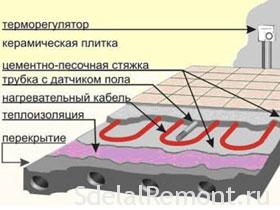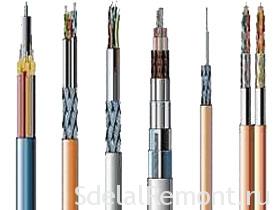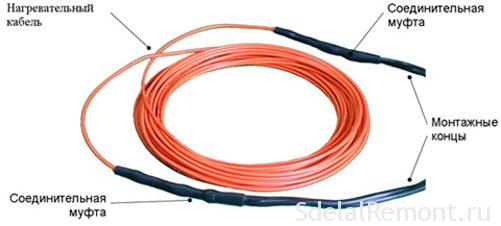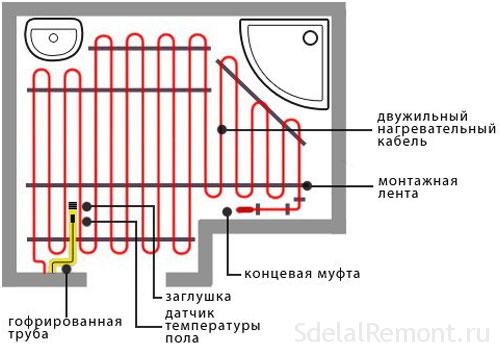Currently, for underfloor heating devices increasingly began to use electricity. In this case is the use of special electric cable, by means of which the floor heating occurs. Site independent repair of apartment, produced good on the device instructions, selection and installation of floor heating with his own hands with photo materials. so, proceed.
Apparatus electric underfloor
Option underfloor, which uses an electric cable, Unlike water heating system, It is available as a private home owners, and those living in urban high-rise buildings. When the electric floor heating device does not require any m ontazha pipes and their connection to the heating system, all work is laying thin electric cable, and connect it to the mains.
ontazha pipes and their connection to the heating system, all work is laying thin electric cable, and connect it to the mains.
System of this floor is much easier to manage, since there is a lot of variety of electronic devices, who will take care of, the temperature was kept at a given level. Such warm floors can be used in a variety of areas, including vacation homes, garden. For example, Using such a system, you can maintain the required temperature in a small country house or set up a timer on so, to the time of departure from the garage room was warmed, for certain engine start.
According to its electrical device warm floor in many ways similar to the heating system, wherein the coolant is water. laying methods also do not differ from the mounting water underfloor, the only difference is only that, that in this case the heating element is a cable.
How to choose electric floor heating. cable types
 According to the principle of the heating cables are divided into two types:
According to the principle of the heating cables are divided into two types:
- self-regulating.
- resistive.
The entire system of the electric floor heating consists of power wires, are laid to connect the system (basically they are laid in the wall), and proper cables, with whose help underfloor heating. To reduce the connection resistance and heating power cables produced with special couplings, as shown in the photo below.
resistive cable
The main heating element is a resistive cable conductor having high resistance, passing at which electric current is converted into thermal energy. In order to avoid electric shock to persons, heating conductor is covered by a layer of insulation, superimposed on top of which a metal braid of. This braid is grounded and is protected by shielding from electromagnetic fields, which arise as a result of. All these layers are covered by the outer insulation. Resistive cables can be as one, and two cores.
single-conductor cable
System, having a single cable, It is the easiest one for the electric underfloor. Its installation is laying the cable on the floor space, what should be provided to connect both ends of the cable to the power supply system, ie the cable is located on the floor in the form of a loop. This system, along with its simplicity has one significant disadvantage, as a result of the flow of electric current is formed on the cable core electromagnetic field. Braid smoothes a physical phenomenon, nor the result is not always satisfactory.
twin cable
The twisted pair cable there is also a current-carrying conductor, which is arranged between two heating wires. Considering that, that an electric current flows in different directions, electromagnetic fields, resulting in different wires, compensate each other. When installing cables resistance should be carefully embed them in mortar, lest there be overheating, and the cable did not come with the system.

Self-regulating cables
Such cables are free from the drawbacks, that is, resistance cables, since here the heating element is a polymer matrix. In the case of one portion overheat, there is a decrease amperage, which affects the heat. This temperature decrease happens portion, while the rest of the system is operating normally. Self-regulating cables have cost several times more from conventional heating cables, but guarantee long life time.
Infrared film warm floor It is a great option when you can not make the screed can be put under laminate or carpet. The advantages are obvious, find out more about film field.
Rules for the calculation of the electric floor heating
When buying a cable, you must first determine the capacity of the entire heating system, per 1m2. Experts advise to adhere to the following selection parameters:
- Bedroom - 100-150 W / m2;
- hallway, corridor, kitchen - 150 W / m2;
- restroom, bathroom - 180 W / m2;
- balcony, loggia - 200W / m2.
Using these data, you can easily determine the power density of a floor heating system. In calculating the area, should be deleted, which is occupied by constantly standing objects (cabinets, sofas, bath, refrigerator, etc.). All these objects interfere with normal air circulation, and this will cause unnecessary energy consumption, and in these places may overheat the cables and their failure.
It should also be borne in mind, that the wiring in a residential area is designed for a maximum of 2 – 4 kW, therefore expecting heating power is necessary to consider this point. Alternatively separate display.
Calculation of power cables is calculated according to the following scheme. If we take for example the area of the bedroom 5 m2, wherein the power is to be 100 W / m2. 100h5 obtain W = 500. In the store you need to pick up a cable, having a corresponding power. the closest, let's, would long cable 24 m, having power 550W. Now we need to calculate the step of laying cable - 5h100 / 24 = 21 cm (S heat distribution x100 / cable length) This will help in our Online calculator for calculating power of the electric floor heating.
installation technology
Before mounting the electric floor heating, you need to determine the location, which will set the thermostat. For this purpose, the wall is necessary to hollow out a hole, in which the mounting box is installed. Usually this is done at the height of 50 – 100 cm. After this procedure is necessary to the installation of the box to bring the power and grounding. The place of installation make the wall groove, of which will go to the power wires to the junction with the heating cable.

After all this work to begin laying cable, after making the heat insulation layer thickness of about 2 cm. The cable is laid on the leveled surface. care should be taken when installing the cable to it, to cable rows are not in contact with each other. The cable is laid under the scheme, obtained in the calculation. It is possible to produce stacking both parallel lines, and a spiral, tk. a big difference in that there is no. Stacking is made on the mounting tape, which fits with the step about 50 cm. It is necessary to carry out the power cables to the thermostat, coupling must always be in the concrete screed. After laying of the heating cable is installed temperature sensor, it should necessarily be mounted in a plastic tube. Before the final casting the floor, check the quality of the cable tester, to avoid repeated disassembly ties in the case of factory defect cable.
To control the temperature to be give preference programmable thermostats, enabling the use of heating while, when the owners are present in the room.
Now, When everything is set up in its place, you can begin to fill screed. If the floor surface is solid, thickness of the screed layer should be more 3 cm, and if you stacked insulating layer, something more 5 cm.
By connecting the heating cable is possible to start when the hardened screed. Screw terminals are on the rear side of the thermostat, to them it is necessary to connect the sensor wires, which determine the floor temperature, as well as the power supply wires from the heating cable and wiring, which feeds the entire system. It is important to connected to the electric panel. If you are not sure, that will be able to properly connect the electric floor heating, we advise you to watch video expert advice.
Mounting of the electric floor heating this completes. For analysis and final selection of the system look, how to make Radiant floor with their hands, mount technology is a little different. maybe, you want to build is a water floor paving. If you have any further questions, feel free to ask them in the comments.
A selection of videos on the selection and installation of electrical floor heating


















